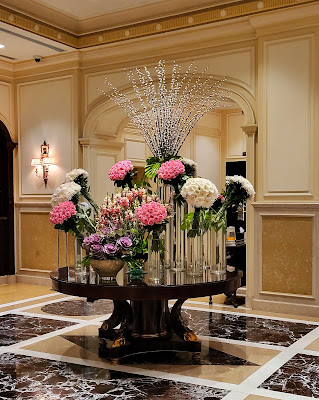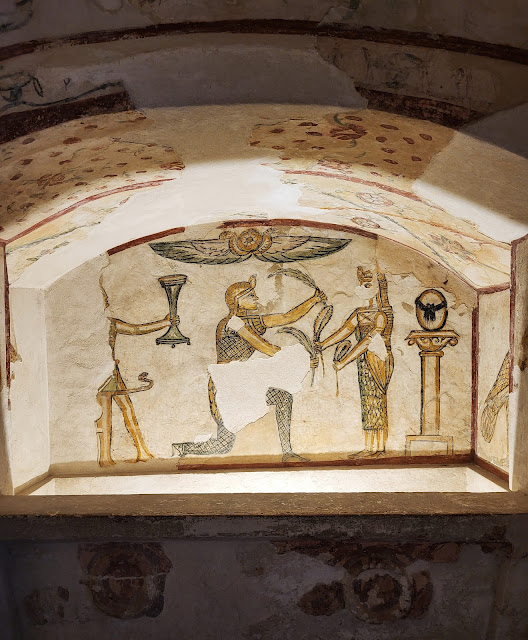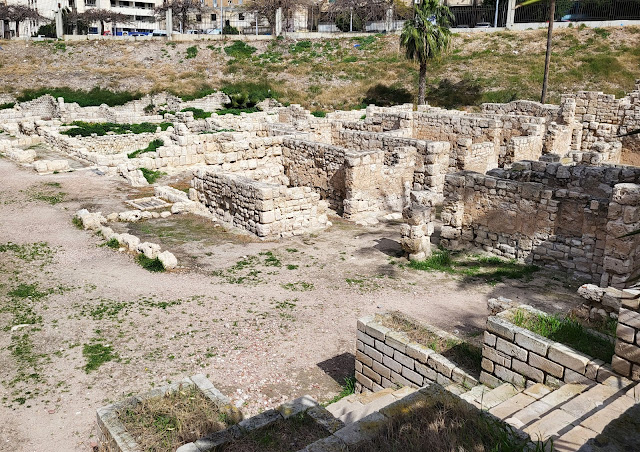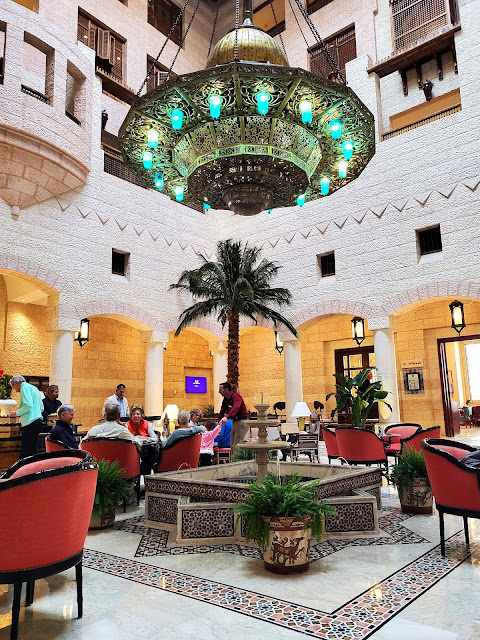February 18 - 19, 2023
The Treasures of Alexandria
Today was a long day of transition…an early morning flight back to
Cairo followed by a four-hour drive. We were happy to discover that our driver, Said (Sah-eed), who had been our driver on our earlier stay in Cairo was with us once again. He picked us up at the airport, then navigated skillfully through the crazy traffic of the city and along the modern highway that would take us to the second largest city of Egypt, Alexandria.
 |
| The view of the landscape of Egypt on our flight from Aswan to Cairo makes it easy to understand why 95% of the population of Egypt lives within a few meters of the Nile River! |
 |
| Starbucks and McDonald's somehow show up in airports everywhere. |
I had been so focused on the ancient Egypt of the Pyramids that I really hadn’t done any research on Alexandria. All I knew was that it once had a lighthouse and a library. I was surprised and delighted with how much it has to offer.
Alexandria was just a small town called Rhacotis when Alexander the Great
arrived here in 331 B.C. He fell in love with this beautiful spot on the Mediterranean Sea and decided to create a city here. The city quickly grew and eventually became the capital of Hellenistic Egypt. After Alexander's death, the port was left under the leadership of his friend
and general, Ptolemy, who eventually had himself declared a god and founded the
Ptolemaic Dynasty, which lasted until the age of Cleopatra VII and the conquest
of the city by Julius Caesar in 47 B.C. And, indeed, the ancient sites we visited during our two days here displayed a blending of Egyptian, Greek, and Roman religions and architecture.
The modern city stretches for over fourteen miles along the coast of
the Mediterranean, with high-rise apartments and hotels lining the coast
highway, dotted here and there with ancient monuments and more recent
historical sites. Said drove us to the
waterfront where our new guide, Zahraa, welcomed us warmly and took us to a nice local
seafood restaurant where we selected our own fish from those caught fresh today.
 |
| The city of Alexandria stretches for miles along the Mediterranean coast. |
 |
| A typical Egyptian lunch |
We followed lunch with a short driving trip along the clear blue water of the sea. Zahraa pointed out the new library, which we would visit the next day, and how the architecture of the office buildings and high-rise apartments had been influenced by other cultures around the Mediterranean, especially Italy. She offered to take us to the fortress that now stands on the site of the ancient lighthouse, but as it had been an exceptionally long day, we decided against any further exploration until the next morning.
 |
| A view of the Bibliotecha Alexandrina, the new Library of Alexandria. |
 |
| Many of the buildings showed European influence from other countries surrounding the Mediterranean Sea. |
 |
| This fortress was built on the site of the original Lighthouse of Alexandria. |
The Four Seasons Alexandria Hotel was lovely. We settled into our room, where our window on
the 14th floor had a splendid view of the Mediterranean coast, called room service for a
light meal, and went to bed early.
 |
| Lobby of the Four Seasons Alexandria Hotel |
 |
| Two weary travelers on our balcony overlooking the sea. |
 |
| Sunset over the Mediterranean Sea |
Our next day was much more
exciting. Alexandria, like Cairo, is built upon the ruins of older civilizations and any time a building comes down, an older one is discovered beneath it.
We
started our day at the catacombs, known as the Tomb of Kom El-Shouqafa and dating from
the first through the fourth centuries. I was surprised to learn that this site pre-dates the catacombs of Rome. These catacombs
were discovered in the late-1800s quite by accident when a donkey fell down a shaft. The attempt to get him out uncovered a
labyrinth of chambers deep in the earth, filled with the bones of those who had
been laid to rest here.
Before descending into the catacombs, we explored the courtyard, which was full of broken columns, headless sphinxes, marble sarcophagi, and the Tigran tomb, all that remained from a large ancient cemetery in another part of Alexandria. Because of the interesting painted artwork that remained, the tomb was re-assembled here next to the Tomb of Kom El-Shouqafa. Both the Temple of Tigran and the catacombs demonstrate the blending of cultures that was taking place in Alexandria, with Greek and Roman additions to the artwork.
 |
| Artifacts in the courtyard of the Tomb of Kom El-Shouqufa |
 |
| Where there is a temple, there have to be temple cats! |
 |
| Water spout |
 |
| The Tigran Tomb was moved to this location. |
 |
| Most of the artwork inside the Tigran Tomb was well-preserved. |
 |
| Egyptian influence was still strong, but the mummy of Osiris lies upon a Roman-style bed. |
 |
| This painting again shows Osiris, entering the Afterlife. |
 |
| The tomb also included Greek influences with this head of Medusa. |
To enter the catacombs, we walked down a
long spiral staircase into the maze of rooms below. The tomb was originally dedicated to the burials of one prominent family. Family members would hold the funeral
celebrations down in the crypt where lovely small temples were carved into the stone and served as “headstones”
for their family members. (We could see
the holes behind the temples where the bodies were slid into their final resting place.) There was even one room with seats around the
edges for a funeral feast…with the rule that all food must be consumed so that
it did not absorb and bring any evil spirits to the surface.
 |
| Bodies would be lowered through the shaft to the catacombs below. |
 |
| The staircase spiraled around the shaft. |
 |
| One of the ornate tombs carved into the rocks of the catacombs. |
 |
| Egyptian and Roman influences in the tombs. |
 |
| Anubis dressed as a Roman soldier |
 |
| Joan and Rob in the Catacombs |
Over the years, more people were buried here, so many rooms were simply rectangles filled with niches where bodies had been placed. (Other than one display containing both human and horse bones, the remains have all been removed, of course.)
 |
| Several of the people were buried with their horses, whose bones were displayed here. |
Our next stop was the Serapeum
(the Temple of the God Serapis), which was once the largest and most magnificent of temples in the Greek quarter of ancient Alexandria.
There is not much left of the temple now, other than pieces of the outer walls, a few broken columns, and a large stone statue of the sacred scarab beetle. The most prominent feature in Pompey’s Pillar, an obelisk erected by the
Romans who occupied this city at the time that the Roman Empire extended all
the way around the Mediterranean Sea. The
pillar, which was erected in honor of the emperor Diocletian, stands atop the small hill and is flanked by two serene sphinxes. Behind the pillar are the
remains of the Piscina, a Roman bath house.
 |
| Pompey's Pillar between two Egyptian sphinxes |
 |
| Sarcophagus |
 |
| Scarab Beetle |
 |
| Around 423 A.D., the Temple of Serapis became a Christian church. |
 |
| I really enjoyed the Mona Lisa smiles on the sphinxes at this site. |
 |
| The Bath House was called the Piscina |
We saw another Roman bath house at
nearby Kom El-Dikka, the site of the Roman theater and its surrounding
buildings. This site dates from the Roman period in Alexandria, between the 1st and 3rd centuries A.D. The excavation of Kom El-Dikka is still on-going. Zahraa, our guide, said that her
grandmother used to play on the mound that once covered this site, never guessing
what lay beneath her feet. Imagine what
discoveries would still be found if a modern city didn’t cover this
region! There is some speculation that
this may be the site of Alexander’s burial, as it has never yet been
discovered.
 |
| The Roman Theater |
 |
| Zahraa, our guide in Alexandria |
Several of the artifacts displayed were gathered from the underwater archaeological site of Qaitbay, lying in the water beneath the site where the famous Lighthouse of Alexandria stood for many centuries before being destroyed between 956 and 1323 A.D. by a series of earthquakes and tsunamis that damaged it and finally swept it and other relics from the ancient city into the sea.
 |
| Obelisk recovered from the underwater site |
 |
| The Sphinx of Psammeticus was one of the most beautiful pieces recovered from the underwater site. It dates from the 500s B.C. |
 |
| The foundations of lecture halls line the road |
 |
| The Roman Baths of El-Dikka |
 |
| The foundations of homes |
 |
| Mosaic floors inside one of the excavated homes |
What would a visit to Alexandria
be without a visit to its famous Library?
Of course, the great library built by Alexander is long gone, burned to
the ground with all its treasures many years ago. But Egypt celebrated its heritage with the
construction of a modern new library, the largest in Egypt and the second largest in the world – second only to the Library of Congress.
(So who did burn the ancient Library? There are three major theories. For those of you who are interested, as I was, here is a link to a short and interesting article: The Burning of the Library of Alexandria )
The Bibliotheca Alexandrina was designed by a
Norwegian architectural company and funded by contributions from many
nations. It is designed to represent the
sun, but with one section cut out – to symbolize that learning is never
finished. The back wall is inscribed
with sayings in the alphabets of every known language.
The immense reading room is used every day by both Egyptian students and
scholars from around the world. It holds
several artifacts from history, including the first printing press to print the
Qu’ran.
 |
| A model of the modern Libary of Alexandria |
 |
| Engravings in the languages of the world. |
 |
| Zahraa tells us about the history of the library. |
 |
| Just a portion of the great Reading Room in the Library of Alexandria |
 |
| The printing press that made the first printed copy of the Qu'ran |
 |
| Other artifacts in the Reading Room |
 |
| Of course, you can't have a library without a section devoted to Shakespeare! |
We ended our busy day with another typically
Egyptian meal at a restaurant next to the site of the famous Lighthouse of
Alexandria, one of the Seven Wonders of the Ancient World. The lighthouse and much of Roman Alexandria
was destroyed in an earthquake and tsunami in the 14th Century. In its place stands a fortress built by
Sultan Ashraft Qaitbay in the 15th Century, built using some of the
stones of the original lighthouse. Below
this small peninsula, submerged beneath the sea, remains a large area of
archaeological treasures.
 |
| The Fortress of Sultan Ashraft Qaitbay |
 |
| A view of the busy harbor in front of Alexandra that sits upon the ruins of the ancient Lighthouse of Alexandria |
 |
| Saying good-bye and setting off for the next adventure! |
After lunch, we said good-bye to
our sweet guide and took the long drive back to Cairo where we checked into
the Meridien Airport Hotel before our early morning flight to Jordan. Phenomenal Petra is coming up!






















































































